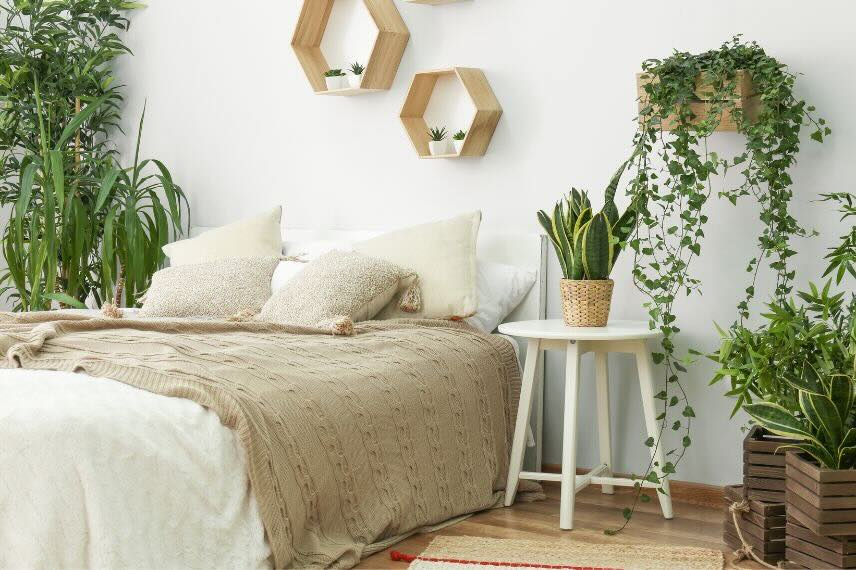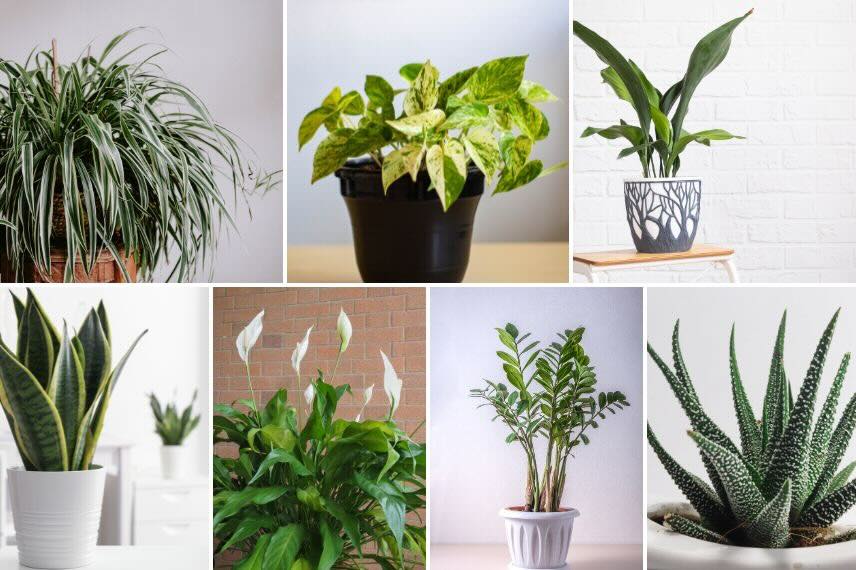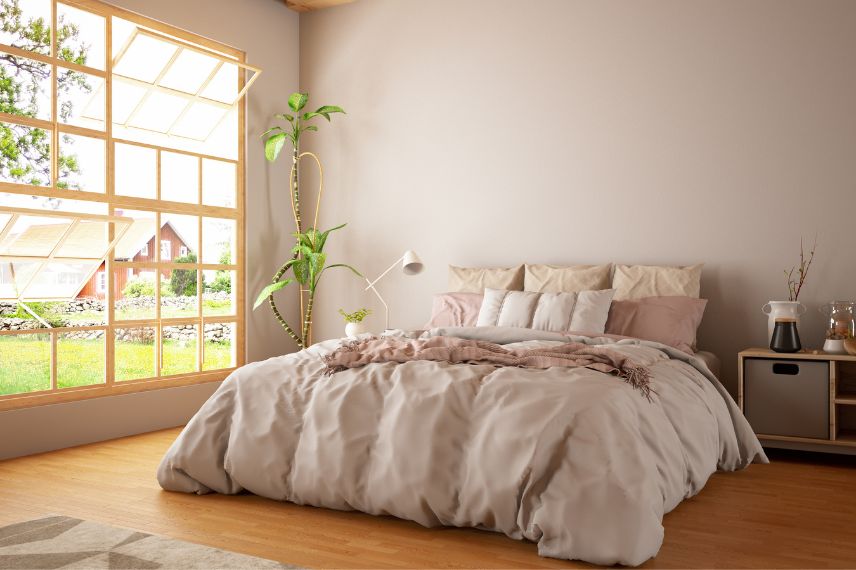
Perfect indoor plants for a bedroom: our practical guide
Selection and advice
Contents
Adding one or two plants to a bedroom might seem insignificant, but it’s often one of the simplest ways to transform a room’s atmosphere. A well-chosen foliage instantly brings a touch of freshness, calm, and sometimes even softness, without cluttering the space. However, not all houseplants are suited to this particular environment.
The bedroom is a place of rest, with often specific conditions: filtered light, drier air, stable but sometimes chilly temperatures in winter. Some plants thrive there, others much less so.
In this article, discover seven houseplants perfectly suited to bedroom life. Easy to care for, aesthetically pleasing without being invasive, they allow you to green a sleeping space effortlessly. Whether the bedroom is bright or moderately lit, there’s something for every taste.

The criteria for an ideal plant for the bedroom
Not all houseplants are suited for bedroom living. Some thrive in the warm humidity of a bathroom, others need full sunlight… To choose the right plant for a bedroom, here are the key criteria to consider:
Tolerance to moderate light
Many bedrooms only have average light levels and few windows.
→ It’s therefore preferable to choose plants that flourish without direct light and remain attractive even in filtered light.
No humidity requirements
Bedroom air is often drier, particularly in winter due to heating and generally throughout the year.
→ Chosen plants should tolerate dry conditions well, without needing misting or a humidifier. This also avoids creating an overly humid climate in the sleeping area.
Moderate growth
A plant that grows too quickly may become cumbersome in a bedroom, especially if space is limited.
→ It’s better to opt for slow-growing varieties or those easy to contain, which will maintain a harmonious shape with minimal pruning.
Calm, non-irritating foliage
In a room dedicated to rest, prioritise non-aggressive foliage that’s non-irritating to touch, and non-fragrant plants (unless the scent is very subtle).
Pet safety
If a cat or dog shares the bedroom, ensure the chosen plant isn’t toxic if ingested.
→ Some very popular plants (like pothos or peace lilies) should be avoided if the pet is of the curious genus.
7 ideal houseplants for a bedroom
Mother-in-law’s Tongue – Sansevieria
Probably the most indestructible plant on this list, the Sansevieria is a champion of adaptation. It tolerates a wide range of light conditions, from dark corners to sunny windows (as long as it doesn’t receive direct scorching sunlight). In bedrooms, it’s particularly valued for thriving in moderate light and its upright habit that takes up little space. There are many varieties: some have long, striate leaves, others are compact, forming rosettes, perfect for shelves or bedside tables.
When it comes to care, it requires very little water: watering every 2 to 3 weeks is sufficient, or even less in winter. However, it dislikes excess moisture, so a well-draining pot is essential. Resilient, elegant, and almost self-sufficient, it’s ideal for those who want greenery without the hassle.
Spider Plant – Chlorophytum
Easily recognisable by its long, slender, arching leaves, often variegated with white, the Chlorophytum is a gentle, lively plant, perfect for creating a natural and airy effect in a bedroom. It can be placed in a pot, grown in a hanging basket, or even positioned on a wardrobe to let its leaves and offsets cascade down.
This is a very tolerant plant: it copes well with medium light, enjoys indirect light, and isn’t too bothered by dry air. It likes moderate but regular watering and can handle occasional neglect without issue. Plus, its rapid growth and tendency to produce “babies” make it a cheerful and generous plant.
ZZ Plant
The Zamioculcas zamiifolia is a sculptural plant, with its thick, glossy stems. It brings a modern, almost graphic style to a room. It tolerates medium light very well, though bright indirect light will encourage more active growth.
Its greatest strength is its drought resistance. Its stems and tuberous roots store water, making it a low-maintenance plant when it comes to watering. It thrives when left alone, making it the perfect companion for forgetful sleepers. A watering every 3 to 4 weeks in a well-draining pot is all it needs.
Pothos
With its heart-shaped leaves and ability to climb or trail, the Pothos (correctly named Epipremnum aureum) is a versatile plant that adapts to almost any setting. It can adorn a shelf, climb along a wall, or cascade from furniture. Its foliage ranges from solid green to variegated with yellow or cream, making it highly decorative even in medium light.
Pothos enjoys indirect light but copes well with slightly darker spots. It prefers moderate watering and likes the soil to dry out between waterings. Its only real drawback: it’s mildly toxic if ingested. If pets sleep in the bedroom, it should be placed out of their reach.
Aspidistra – Cast Iron Plant
The Aspidistra lives up to its nickname: it’s exceptionally hardy. Its broad, glossy, deep green foliage gives a peaceful, slightly vintage feel to a room. It grows slowly, asks for almost nothing, and can endure tough conditions: low light, infrequent watering, temperature fluctuations…
It’s the perfect plant for dimly lit bedrooms, unheated rooms, or for those who occasionally forget their plants. It thrives on neglect, rarely needs repotting, and handles drought well. Its low, dense habit makes it discreet yet reassuring.
Aloe Vera
Aloe vera, understated and graphic, suits modern, minimalist, and bright bedrooms perfectly. It enjoys strong light, even a bit of direct sunlight, making it a good choice for south- or west-facing rooms. In insufficient light, it may become leggy.
Care-wise, it requires very little watering: once every two to three weeks is plenty. Like all succulents, it hates waterlogged soil, so good drainage is essential. Its compact shape and tidy appearance make it ideal for a shelf, side table, or windowsill.
Peace Lily – Spathiphyllum
The Spathiphyllum is an elegant plant with dense foliage, often highlighted by its white, sail-like flowers. In a well-lit bedroom, it adds a soft, refined touch. It needs fairly abundant indirect light to flower well—a dark room won’t suit it.
It appreciates some humidity but can adapt to moderately dry bedrooms with regular watering. An occasional dusting of its leaves helps maintain their shine. With its graceful appearance, it fits perfectly into a calm, restful setting.

Clockwise from top left: Chlorophytum, Pothos, Aspidistra, Aloe vera, Zamioculcas, Spathiphyllum, Sansevieria
Precautions to take when considering plants in a bedroom
Adding plants to a bedroom is an excellent idea for creating a calming and natural atmosphere. However, this particular space comes with its own constraints. Here are a few points to consider to ensure the well-being of the plant… and the occupants.
Avoid excess moisture
Watering is often the first mistake. Too much water in a pot can:
-
lead to root rot,
-
cause unpleasant odours,
-
or even create an unhealthy environment in a room dedicated to rest.
→ It is therefore advisable to water carefully and to check regularly that there is no stagnant water at the bottom of the pot, especially in winter when the plant drinks less.
Choose a stable location
The temperature in a bedroom is generally moderate, but beware:
-
Avoid cold draughts near windows in winter.
-
Do not place plants too close to radiators, which dry out the air and damage foliage.
-
Also avoid poorly insulated windowsills.
Opt for plants with subtle foliage
Some flowering plants, such as jasmines or gardenias, can emit a strong fragrance.
→ While pleasant in a living room, this scent may disturb sleep or cause headaches in sensitive individuals.
It’s best to choose therefore lightly scented plants for this space.
Avoid overcrowding the space
The idea isn’t to turn the bedroom into a jungle!
→ One or two well-chosen plants are enough to create a soothing atmosphere, without hindering air circulation or room maintenance.

A single plant, well placed and of good stature, is enough to infuse a zen natural spirit and a welcome touch of colour in a bedroom with peaceful tones
- Subscribe!
- Contents































Comments